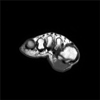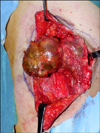Abstract
Chronic expanding hematoma (CEH) is a rare, slow-developing disease that occurs months to years after trauma or surgery. Most CEH in soft tissue occurs in the thigh or upper extremities and can occur with or without an inducible cause. Ninety-one cases of CEH in soft tissue have been reported previously in the Japanese and English literature but its occurrence on the sole has not been reported. Here, we report four cases of successfully treated CEH, including a case occurring on the sole, and provide a review of the literature.
Chronic expanding hematoma (CEH) is a rare, slow-developing disease that occurs months to years after trauma or surgery. Ninety-one cases of CEH in soft tissue have been reported previously in the Japanese and English literature, but its occurrence on the sole has not been reported. Here, we report four cases of successfully treated CEH and review the literature.
Case 1 was a 40-year-old man who presented with painless swelling of the right sole that increased gradually in size for 4 months. An examination revealed a firm, skin-colored, subcutaneous tumor adhering to the skin (Fig. 1). There was no recent history of trauma or anticoagulant medication. A laboratory examination, including a coagulation profile, was within normal limits. A magnetic resonance imaging (MRI) examination revealed a 2.5×2.5 cm well-encapsulated mass, which was removed completely by surgery (Fig. 2). A histopathological examination revealed a fibrotic capsule, inflammatory cellular infiltration, and organized blood (Fig. 3, 4); the lesion was diagnosed as CEH. The patient's postoperative course was uneventful and his tumor has not recurred after 2 years.
Case 2 was a 54-year-old man who presented with a 10-year history of a large mass in the left thigh. The surface was dark-reddish, soft, fluctuant, and painless when palpitated. A firm subcutaneous tumor was situated lateral to the lesion. The patient had had an injection (detailed information was not available) in his left thigh during childhood, and a large hematoma initially appeared at the injection site. The hematoma resolved immediately, leaving a small induration that increased rapidly in size 1 year ago. His medical and family history was otherwise unremarkable except for having hepatitis B carrier status. Blood biochemistry, coagulation profile, and platelet counts were normal. An MRI scan demonstrated a well-circumscribed, subcutaneous, 4×4×5 cm cystic mass (Fig. 5). The patient underwent complete resection of the mass including the fibrous capsule, which had partly adhered to the fascia (Fig. 6). The lesion was removed surgically, and microscopically, the resection revealed a hematoma surrounded by a hyalinized fibrous capsule. No recurrence was detected within 2 years.
A 66-year-old woman (Case 3) presented with a painful 6 months old and increasingly large swelling on the buttock. She had no history of trauma. Clinical and MRI findings revealed a tender 10×10 cm cystic swelling in the subcutaneous tissue. An incision biopsy confirmed that the swelling was a hematoma. Because the patient was receiving anticoagulant therapy including 2 mg/day warfarin potassium and 100 mg/day aspirin for anti-phospholipid antibody syndrome, the hematoma was aspirated rather than complete dissection. The mass has not recurred after 3 years.
A 14-year-old girl (Case 4) noted a cystic, slightly tender, 1.5×1.5 cm swelling on the right upper arm 3 months prior to consultation. No inducible cause could be discovered and her history was unremarkable. She successfully underwent enucleation of the lesion at Kyushu University Hospital. Her condition was histopathologically diagnosed as CEH. The swelling has not recurred after 2 years.
Soft tissue CEH is a rare entity. Friedlander and Bump1 first reported CEH occurring in a calf. In 1980, Reid et al.2 defined CEH as a hematoma, which more than 1 month after initial hemorrhage, is characterized by its persistence and increasing size. The terms 'ancient hematoma' and 'posttraumatic cyst of soft tissue' have been used to describe this entity. Most hematomas resolve spontaneously without serious clinical complications, but some may persist and present as slowly expanding lesions that occasionally mimic soft-tissue neoplasms such as sarcoma. No evidence of malignancy was detected in our cases but careful follow-up will be necessary, as an angiosarcoma occurring in a CEH has been reported3. No definitive etiology has been described for CEH, and it may develop either spontaneously or in regions of previous trauma or surgery. It has been speculated that an initial trauma can displace skin and subcutaneous fatty tissue from underlying tissue, leading to the formation of blood-filled cysts surrounded by dense fibrous tissue. Continued inflammation under this fibrous capsule, including the cellular breakdown products of leukocytes, erythrocytes, and platelets causes further damage and bleeding from capillaries4.
In our review of the Japanese and English literature, we found 91 cases of CEH including those presented here (Table 1). The 91 cases had a broad age distribution; 64 (70.3%) were male and 27 (29.7%) were female. Lesions were predominantly on the lower extremities and trunk. CEH on the sole, as seen in Case 1, has not been reported previously. An antecedent episode of trauma or surgery was evident in 57 cases (62.6%). The range of clinical latent periods was wide, ranging from 1 month to 57 years (Table 1). Complete excision yielded the best clinical outcomes, but eight CEH cases decreased in size or resolved without any aggressive treatment5.
In conclusion, we present four cases of CEH with a literature review of this uncommon disease. In addition, this is the first report presenting CEH on the sole.
Figures and Tables
Fig. 2
T1-weighted magnetic resonance imaging scan demonstrated a well-circumscribed cystic mass on the sole.

Fig. 3
A fibrotic capsule, inflammatory cellular infiltration, and organized blood were observed (H&E, ×40).

Fig. 4
The capsule consisted of hyalinized fibrous tissue with new capillaries and inflammatory cells (H&E, ×100).

References
1. Friedlander HL, Bump RG. Chronic expanding hematoma of the calf. A case report. J Bone Joint Surg Am. 1968; 50:1237–1241.
2. Reid JD, Kommareddi S, Lankerani M, Park MC. Chronic expanding hematomas. A clinicopathologic entity. JAMA. 1980; 244:2441–2442.

3. Miyazaki H, Goto A, Hino R, Ota S, Okudaira R, Murakawa T, et al. Pleural cavity angiosarcoma arising in chronic expanding hematoma after pneumonectomy. Hum Pathol. 2011; 42:1576–1579.

4. Labadie EL, Glover D. Physiopathogenesis of subdural hematomas. Part 1: histological and biochemical comparisons of subcutaneous hematoma in rats with subdural hematoma in man. J Neurosurg. 1976; 45:382–392.




 PDF
PDF ePub
ePub Citation
Citation Print
Print






 XML Download
XML Download